As an electric power company that is responsible for approximately 10% of total CO2 emissions in Japan, TEPCO places high priority on addressing global warming. By focusing on initiatives on the electricity supply and demand sides, TEPCO contributes to the realization of a low-carbon society.
We promote the low-carbon, high-efficiency power generation, technical development for the reduction of CO2 emissions, and other means of producing low-CO2 electricity. At the same time, we also make active efforts to achieve energy-efficient utilization of electricity, such as by promoting electrification, disseminating high-efficiency products and promoting energy-saving lifestyles.
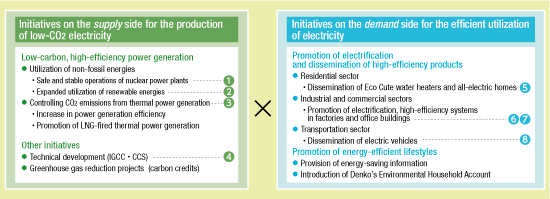
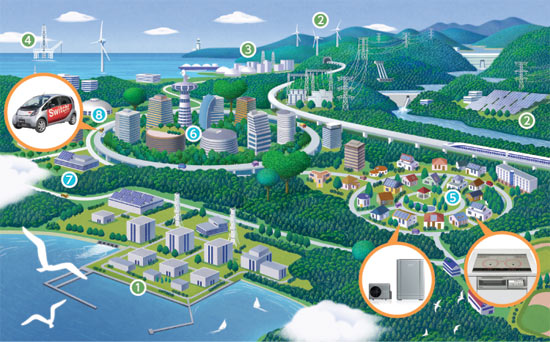
TEPCO is making active efforts to achieve the voluntary target of "reducing CO2 emission intensity by 20% on average during the five years from FY2008 to FY2012 compared to the FY1990 level."
* CO2 emission intensity
CO2 emission intensity is the amount of CO2 emitted when 1 kWh of electricity is used (kg-CO2/kWh). Because electricity usage varies depending on customer requirements such as economic activities and on weather conditions, electric power companies establish CO2 reduction targets in terms of CO2 emission intensity.
CO2 emissions in FY2009 decreased 11% from FY2008 to 107.5 million tons, as a result of the recommissioning of Units 6 and 7 at the Kashiwazaki-Kariwa Nuclear Power Station, increased thermal power generation efficiency, and a drop in fossil fuel consumption accompanying a decline in power sales. With the use of carbon credits, CO2 emission intensity came to 0.324 kg-CO2/kWh*. We will continue our efforts toward attainment of our voluntary target.
* CO2 emission intensity after reflecting carbon credits based on the Law Concerning the Promotion of Measures to Cope with Global Warming (company-specific emission factors)
TEPCO's voluntary reduction target for CO2 emission intensity and progress of attainment
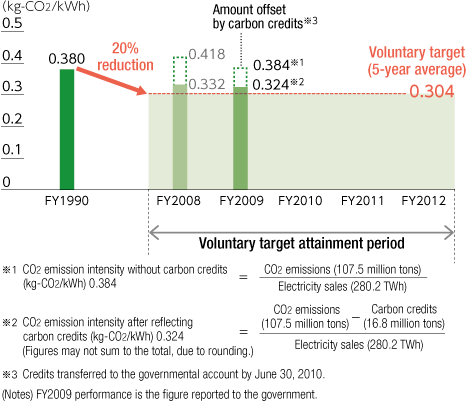
FY2009 CO2 emission intensity values are reported to the government by each electric power company, confirmed by the government, and announced as company-specific emission factors.
Global CO2 emissions have continued to increase mainly in emerging countries such as China and India, but the current Kyoto Protocol specifies emission reduction targets up to 2012 for developed countries only. For this reason, the "post-Kyoto" framework should include all major emitters in order to become more effective. The 15th Conference of Parties to the Framework Convention on Climate Change (COP15) was held at the end of 2009, and although no agreement on the post-Kyoto framework was reached, approximately 30 developed and developing countries adopted the Copenhagen Accord*. Widespread attention will continue to focus on further debates concerning the next framework.
* Copenhagen Accord
An agreement on the major principles and direction of the post-Kyoto framework, including emission reduction targets of developed countries and emission reduction actions by developing countries. 137 countries have expressed their intention to associate themselves with the accord as of August 6, 2010.
Global CO2 emission forecast
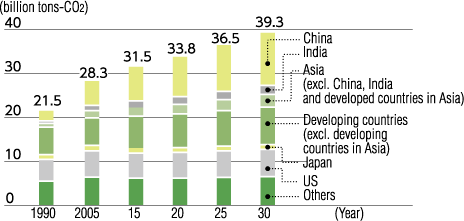 Source: 1990 data from EIA, “International Energy Outlook 2009”
Source: 1990 data from EIA, “International Energy Outlook 2009”
Data for other years from EIA, “International Energy Outlook 2010”
Japan's greenhouse gas emissions totaled 1,282 million tons in FY2008, and exceeded base-year emission levels*1 under the Kyoto Protocol by 1.6%. In September 2009, then-Prime Minister Yukio Hatoyama announced Japan's medium-term reduction target*2 for 2020 at the United Nations Summit on Climate Change.
* Base years under the Kyoto Protocol
CO2, CH4, N2O: 1990
HFCs, PFCs, SF6: 1995
* Medium-term target
Target to reduce Japan's greenhouse gas emissions by 25% by 2020 compared to the 1990 level, premised on the establishment of a fair and effective international framework in which all major economies participate and on their agreement to ambitious targets. It does not specify the breakdown of the 25% reduction (domestic countermeasures, purchase of carbon credits from foreign countries, etc.).
Japan’s greenhouse gas emissions
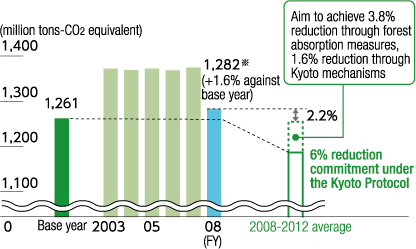 *Does not factor in forest absorption measures and the Kyoto mechanism of carbon credits.
*Does not factor in forest absorption measures and the Kyoto mechanism of carbon credits.
Source: Based on press releases issued by the Ministry of the Environment
© Tokyo Electric Power Company Holdings, Inc.